| |
MODERNITY’S UNDERCURRENTS
In celebrating Tokyo’s rebirth, the “creative prints” (sōsaku-hanga) artists revealed themselves to be thoroughly bourgeois urbanites. Industrialization drew their attention mostly in the form of engineering projects, smokestacks, Western-style buildings, and the revolution in mass transportation. Working-class activities were observed fleetingly at best. In Koizumi’s series, for example, this includes dying cloth for kimono and two contrasting versions of a picturesque lumberyard.
|
|
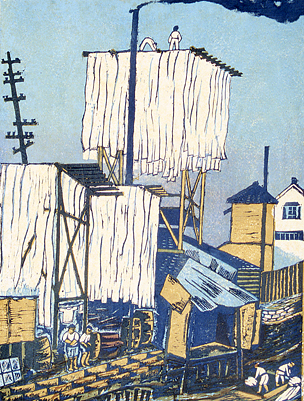 |
  “This is an unusual view from the old days,” Koizumi wrote in his 1940 annotation for this print created ten years earlier. “I wonder if it still exists?” “This is an unusual view from the old days,” Koizumi wrote in his 1940 annotation for this print created ten years earlier. “I wonder if it still exists?”
“Dye Factory at Waseda (#08),”
November 1930 |
“Lumberyards at
Kiba (#65),”
July 1935 |
 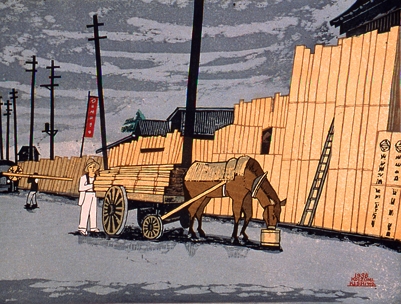 |
“Lumberyards at
Kiba in the Snow
(#65-revised),”
February 1940
Private collection |
 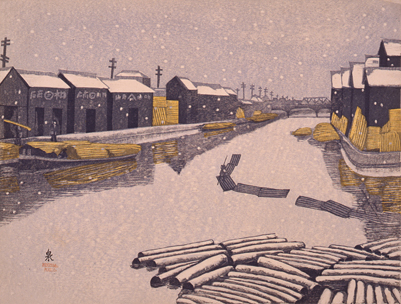 |
| |
The only hint of agriculture—and the fact that the great majority of Japan’s population was engaged in this—was Koizumi’s rendering of the new central vegetable market in Kanda, and a nostalgic depiction of a post-earthquake suburb where daikon, the succulent big white radish, was still grown.
|
|

 “Vegetable Market at Kanda (#16),” September 1931 “Vegetable Market at Kanda (#16),” September 1931
Damage from the earthquake required the reconstruction of Tokyo's food markets, including the Central Wholesale Market at Tsukij. Vegetable sales were transacted under tented stalls along the Kanda River to facilitate the shipping of goods. The concrete-and-glass warehouse was built to withstand future earthquakes and fire.
|
Harvesting daikon.
“Landscape at
Nerima Ward (#73),”
November 1935 |
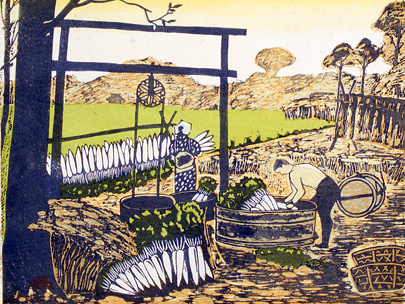 |
 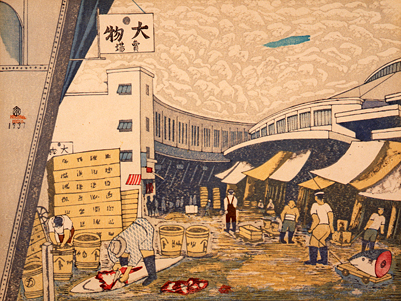
|
 
Evocation of the other large demographic sector that fed the nation emerged only in depictions of the great Tsukiji fish market and drying edible seaweed in Ōmori. |
“Tsukiji Fish Market (#98),”
October 1937 |
 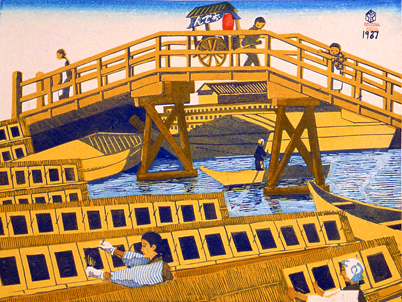 |
“Drying Seaweed at
Ōmori (#86),”
February 1937 |
| |
This was only natural in print sets devoted to urban renewal. At the same time, it reflected only one highly select corner of modernizing Japan. There was no intimation of great discrepancies between the urban and rural sectors in modernization and living standards; no real sense of the ever-growing male and female working-class population that lived in the city in less attractive “modern” conditions; no hint of social upheaval in the form of the burgeoning labor and women’s movements. In one peaceful scene, Koizumi gave his viewers an idyllic picture of lower-class urbanites fishing in a canal. It remained for an entirely different cadre of graphic artists to convey social tensions, including for example election posters calling on workers and farmers to unite against their oppressors.
|
|
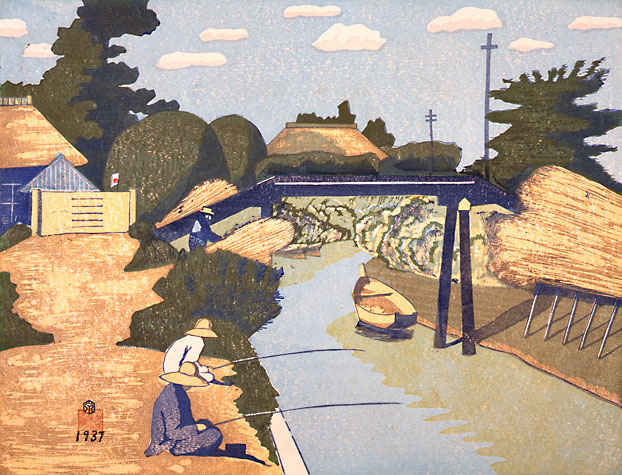 |

 “Horie-Machi in Kasai (#97),” September 1937 “Horie-Machi in Kasai (#97),” September 1937
Private collection
Koizumi’s caption for this pastoral image captures his generally romantic impression of lower-class city life. “A small stream meanders,” this reads. “From the embankment anglers are intent on landing small fish.”
|
| |
What Koizumi and his colleagues did capture was contradictions and undercurrents of a different sort. One of these, of course, is apparent to us only in retrospect: the poignant knowledge that the reborn city would be wiped out again, by war, within a matter of years. At the same time, Koizumi also worked many “subtexts” into his selection of subjects. Some of this is more or less obvious. Some of it takes specialized knowledge of Japanese history to grasp. |
|


After his “100 Views” was completed late in 1940, Koizumi prepared an idiosyncratic list of cryptic comments or captions about each print to accompany the full, marketed set. Often whimsical and sometimes just strange, these occasionally shed unexpected light on his choice of subjects. |
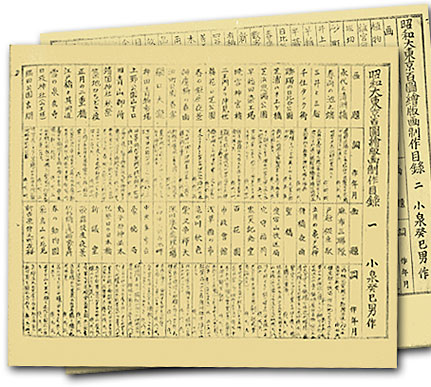 |
Koizumi’s 1940
annotations about
his “100 Views” |
| |
As the captions help highlight, one major undercurrent in Koizumi’s new Tokyo was the persistence of the past. A second was the pervasive presence of the emperor and imperial system. And a third was the growing visibility of the military.
The Past in the Present
Many of the sites Koizumi celebrated represented perseverance and continuity—the survival of old structures or relics or, if nothing remained, just the memory of what may once have existed. The “place” itself still remained integral to the spiritual identity of the city. A particularly subtle example of this is the evocative rendering of a woman under lamplight by the entrance to Ueno Park. To all appearances, this is a thoroughly cosmopolitan scene: a modern woman in Western dress walking alone at night in the electrified city. There is even a touch of red neon in the night sky.
|
|
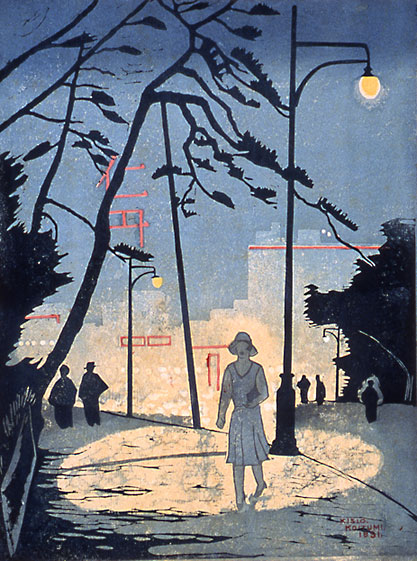 |

 “Yamashita Entrance to Ueno Park (#17),” “Yamashita Entrance to Ueno Park (#17),”
September 1931
Koizumi’s interest in the past surfaced in his comment on this cosmopolitan scene of a modern woman in Western dress walking alone at night, illuminated by the street lights (and a hint of red neon) in Ueno Park:
“In the era of the shoguns, the ‘Black Gate’ stood at this site. The remaining pines do not comment on this.” |
| |
To most Japanese, however, “Ueno Park” also was resonant with intimations of the past. In the early 1600s, the first Tokugawa shogun had selected this area as an auspicious site for a temple that would guard his castle and city from evil forces. (In traditional geomancy, evil was thought to come from the northeast.) In 1868, Ueno was the site of a bloody last-ditch battle ending the civil conflict in which the shogunate was overthrown. And in 1923, the site became a temporary shelter for many city residents displaced by the earthquake. Koizumi’s cryptic caption for this print nicely captures his highly impressionist sense of the past in the present. “In the era of the shoguns, the ‘Black Gate’ stood at this site,” this reads. “The remaining pines do not comment on this.”
The “100 Views” also includes less indirect evocations of Tokyo’s feudal and often bloody past. Most obvious, perhaps, is Koizumi’s unusually conventional rendering of the Sakuradamon, or Cherry Blossom Gate of the shogun’s former castle, in a blizzard.
|
|

 “Snow at Sakurada Gate (#75),” “Snow at Sakurada Gate (#75),”
February 1936
Koizumi’s cryptic annotation for this print was “I wonder if it was snowing like this when Foreign Minister Ii was assassinated by loyal samurai from Mito.” He was referring to a famous incident in 1860 | 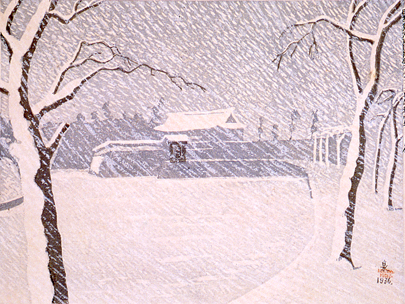 |
| |
This was the site of the celebrated assassination of Ii Naosuke (1815–1860), a high adviser to the shogun who had engineered the opening of the country to the foreign powers after Commodore Perry’s visits in 1853 and 1854. Ii’s palanquin being attacked in the snow by samurai who opposed abandoning national seclusion was a favorite subject of woodblock artists at the time, and Koizumi’s caption zeros in on this association.
|
|
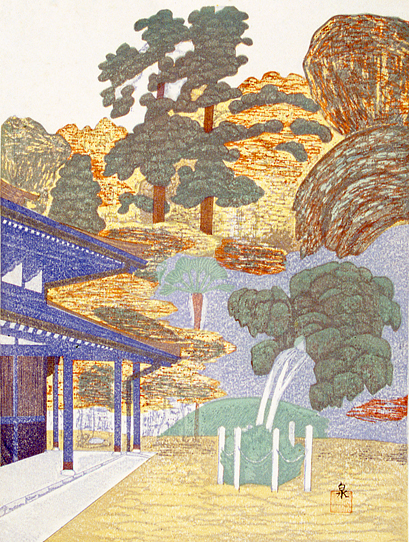 |


Concerning his selection of another site in the series, the Buddhist temple Gōtokuji, Koizumi’s notation in full is simply that “This is the burial place of Lord Ii who was killed at Sakuradamon. It is also famous for a literal mountain of cat statues.” |
“Gōtokuji Temple at
Setagaya Ward (#42),”
October 1933)
|
| |
Koizumi’s Sakuradamon print also obliquely evokes events involving the throne that all Japanese would know intimately. One was an attempted assassination of Emperor Hirohito by a bomb-throwing Korean at that site on January 8, 1932. (An earlier attempt on Hirohito’s life took place just after the earthquake in 1923, when he was crown prince.) The other was the notorious “Two-Two-Six Incident” of February 26, 1936, in which a cabal of junior officers claiming to represent the true interests of the throne took command of about 1,500 sympathetic troops, surrounded the Diet (parliament) and other government buildings, and carried out attacks on key ministers. Their goal was more rigorous overseas expansionist policies and, at home, elimination of corrupt, inefficient representative government and its replacement by something akin to a military dictatorship under the emperor. The emperor refused to support this attempted coup, and photographs of the military rebels at Sakuradamon and elsewhere—again in the snow—became part of the iconic imagery of mid–1930s Japan. As it happens, Koizumi’s Sakuradamon print is dated February 1936, and thus was almost surely done just prior to the coup. Be that as it may, it would have immediately assumed this larger ambiance
Yet another provocative selection is the temple Sengakuji, famous as the burial place of Asano Naganori (1665–1701) and 46 of his loyal retainers. (The familiar number is 47, but one dropped out of the picture before events ran their full course.)
|
|
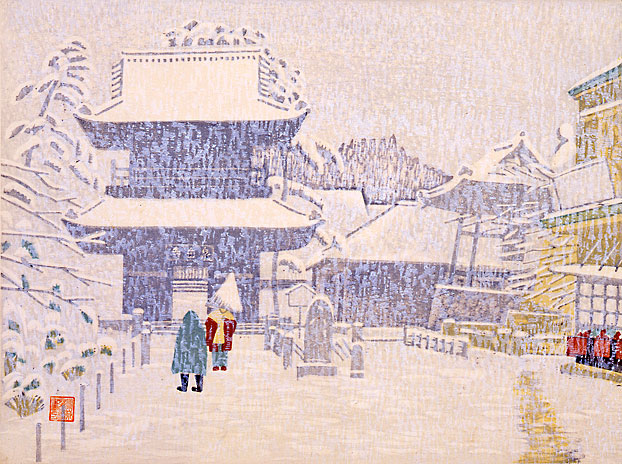 |

 “Sengakuji Temple in the Snow (#23),” March 1932 “Sengakuji Temple in the Snow (#23),” March 1932
“Seeing this temple in the snow,” Koizumi wrote, “reminded me of the 47 Loyal Retainers.” He was referring to a famous vendetta in 1703.
Private collection
|
| |
Asano was the daimyo of the small Harima domain, near Osaka. In 1701, while preparing for his assigned role as a shogunal representative in the ritual reception of New Year’s greetings from the emperor at Edo Castle, Asano was deeply offended by the haughty attitude of Kira Yoshinaka (1641–1703), a high-ranking shogunal official. After Asano attacked Kira with a sword, a capital offense within the castle precincts, the shogun required that he take his own life. Asano’s retainers plotted revenge, and in 1703 assassinated Kira at his mansion in Edo. The sensational vendetta provoked varied and complex responses. The shogun and his advisors, while appreciating the loyalty of the now masterless samurai, saw the civil order violated and demanded that all of the retainers commit ritual suicide. The public at large, however, seemed to side with the retainers—who all complied with the shogun’s order. Their cremated ashes were buried alongside their master’s at Sengakuji.
As it happened, just as was the case with both Ii’s assassination in 1860 and the February 26 Incident in 1936, snow was falling when the loyal retainers killed Kira—creating a scene replicated time and time again in prints, theater, and later cinema. Koizumi’s caption for his Sengakuji print reads simply, “Seeing this temple in the snow reminded me of the 47 Loyal Retainers. I used a new technique to render the snow.”
|
|
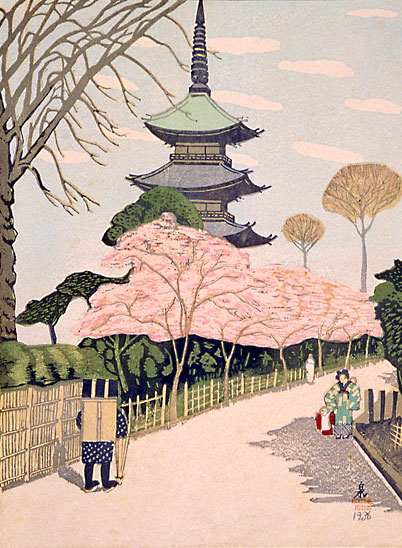
|
  Several other sites celebrated by Koizumi also involve intriguing evocations of the feudal past. His 1936 rendering of the pagoda at Yanaka Tennōji, for example, depicts the only remaining architectural element of a temple that was another site of pitched battle between shogunal and pro-emperor forces in 1868. The loyalists were victorious, much of the temple was destroyed in the battle, and the pagoda, situated in the midst of a cemetery, also survived the Kantō earthquake. Several other sites celebrated by Koizumi also involve intriguing evocations of the feudal past. His 1936 rendering of the pagoda at Yanaka Tennōji, for example, depicts the only remaining architectural element of a temple that was another site of pitched battle between shogunal and pro-emperor forces in 1868. The loyalists were victorious, much of the temple was destroyed in the battle, and the pagoda, situated in the midst of a cemetery, also survived the Kantō earthquake.
|
“Pagoda of Tennōji Temple
at Yanaka (#78),”
May 1936
|
| |
In 1935 and then again five years later, as he brought his “100 Views” to a close, Koizumi produced two versions of a particularly puzzling site: the feudal-era execution grounds at Suzugamori.
|
|
  The second of these prints featured a memorial slab bearing the time-honored Buddhist invocation of the merciful Amida Buddha (Namu Amida Butsu). Koizumi’s caption merely observes that this site was the setting of a famous scene in a Kabuki play first performed in 1816, and we are left to wonder what he really had in mind. (In the play, a highly fanciful encounter takes place between a ne’er-do-well about to be executed who is rescued by a beautiful woman in what turns out to be a dream.) The second of these prints featured a memorial slab bearing the time-honored Buddhist invocation of the merciful Amida Buddha (Namu Amida Butsu). Koizumi’s caption merely observes that this site was the setting of a famous scene in a Kabuki play first performed in 1816, and we are left to wonder what he really had in mind. (In the play, a highly fanciful encounter takes place between a ne’er-do-well about to be executed who is rescued by a beautiful woman in what turns out to be a dream.)
| 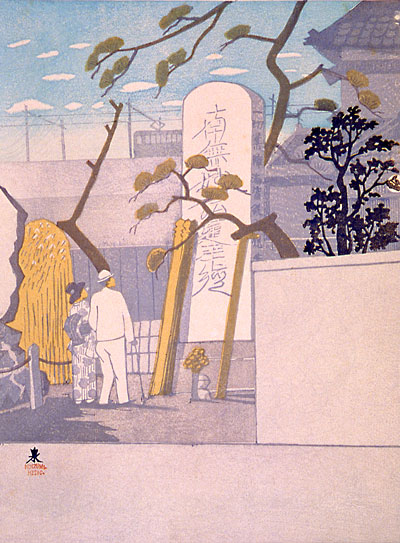
|
“Former Execution Ground
at Suzugamori (71-revised),”
August 1940)
|
| |
Was his attraction to this grisly place a subtle allusion to the heavy hand of the state? Was it a statement about the ultimate consequences in store for those oppose authority—even corrupt authority, as the rebels in the February 26 Incident proclaimed—in search of a greater good? We are left with a haunting image that begs explanation.
The Imperial Presence
In 1926, three years after the earthquake, Hirohito inherited the throne and Japan started its calendar over again. The new imperial reign was given the auspicious name Shōwa (Bright Peace), and 1926 became, in this modern Japanese way of calculating the years, Shōwa 1. Hirohito himself was identified most commonly as the Shōwa emperor.
The auspicious reign name was a misnomer, although this was not obvious at first. Hirohito’s father, the Taishō emperor who reigned from 1911 to 1926, had been feeble and incompetent, and the new sovereign’s advisers took care to ensure he would be a more authoritative monarch. There were many reasons for the ruling elites to be concerned about social stability. Liberalizing trends popularly known as “Taishō democracy” had flourished during Hirohito’s father’s reign. Both rightwing and leftwing movements were on the rise. The Kantō earthquake itself had exposed social tensions in the most vicious way imaginable, in the vigilante slaughter of Koreans that took place in its wake. And worse was to come: rising anti-foreign nationalism in China; the collapse of global capitalism in 1929 (and devastating impact of depression on Japan’s rural areas in particular); the successful military conspiracy known as the Manchurian Incident in 1931, and Japan’s withdrawal from the League of Nations in 1933 after that international body condemned its creation of the puppet state of Manchukuo.
Within Japan, the ideological response to this turmoil was to pump emperor-centered nationalism to unprecedented levels. Thus, at the very moment Koizumi and his compatriots were celebrating rebirth, modernity, and the emergence of a truly cosmopolitan metropolis, Tokyo—like the nation as a whole— also was being suffused with a carefully choreographed sense of national, racial, and spiritual uniqueness exemplified by the ubiquitous imperial presence. This is the second strong undercurrent that closer scrutiny of Koizumi’s “100 Views of Great Tokyo in the Shōwa Era” reveals.
Some of this was simply conveyed by representations of the Imperial Palace. After 1868, the imperial court was relocated from its traditional base in Kyoto to the newly designated “Eastern Capital” in Tokyo—that is what the two ideographs for Tokyo mean—and the old Edo Castle that had been the seat of power of the Tokugawa shoguns became the new imperial enclave. As originally conceived in plans dating from the early 17th century and laid out in accordance with Chinese geomancy, Edo Castle lay at the heart of the city. As the feudal and then modern city expanded, the sprawling site increasingly fell into its eastern sector.
|
|
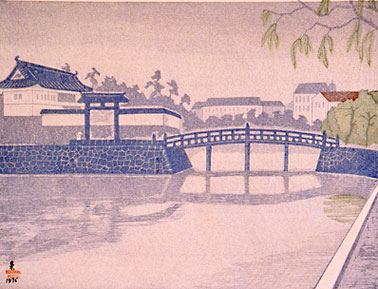
|   In any case, the emperor’s actual “palace” was never seen. Rather, gates, bridges, moats, and other fragments of the old and largely destroyed Edo Castle came to subtly exemplify not only the imperial presence, but also the deeper feudal history of a secluded, isolated land. In any case, the emperor’s actual “palace” was never seen. Rather, gates, bridges, moats, and other fragments of the old and largely destroyed Edo Castle came to subtly exemplify not only the imperial presence, but also the deeper feudal history of a secluded, isolated land. |
“Pagoda of Tennōji Temple
at Yanaka (#78),”
May 1936
|
| |
In 1935 and then again five years later, as he brought his “100 Views” to a close, Koizumi produced two versions of a particularly puzzling site: the feudal-era execution grounds at Suzugamori.
|
|
  “Nijū Bridge on New Year’s Day (#21),” “Nijū Bridge on New Year’s Day (#21),”
January 1932
This stone bridge, built in 1887, was the primary ceremonial bridge that the emperor and important visitors used to enter the grounds of the palace. It survived the earthquake to become another symbol of continuity.
|
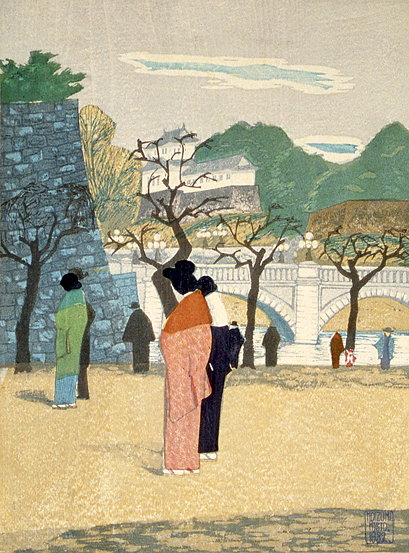
|
| |
Other representations of the imperial presence were even more indirect. Several prints, for example, depict sites associated with commemoration of Hirohito’s grandfather, the Meiji emperor (#9, #72). Yasukuni Shrine (#19), a major landmark in anyone’s rendering of the modern city, was established by the new Meiji government in the 1870s to promote State Shinto and venerate the souls of all who died fighting for the emperor. Koizumi’s annotation for his rendering of the famous Nihonbashi bridge tells us that the festive decorations he includes are celebrating “the birth of the Crown Prince.” (Hirohito’s first son and later successor, Akihito, was born on December 23, 1933, and Koizumi’s print is dated January 1934.)
|
|

 “Nihon Bridge on a Holiday (#44), January 1934,” “Nihon Bridge on a Holiday (#44), January 1934,”
The holiday being celebrated was “the birth of the
Crown Prince” the previous month. |
| |
Koizumi’s print of the Akasaka detached palace, where guests of state resided and whose spacious grounds included the residences of imperial princes, adds additional layers of allusion to the imperial presence. This rather bizarre Versailles-like structure—a bit of old Europe in the middle of Tokyo—reflects the degree to which the modern monarchy sought architectural justification and resonance by quoting European palaces and halls of state.
|
|
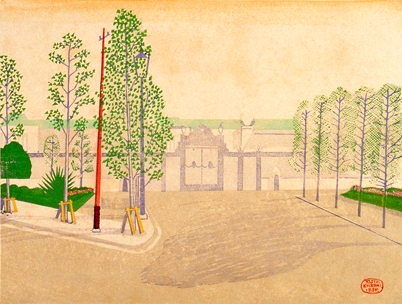
|   Koizumi’s notation calls it “beautiful like a palace in a fairyland”—and goes on to observe that Pu Yi, the puppet emperor of Manchukuo, stayed there two times.” Koizumi’s notation calls it “beautiful like a palace in a fairyland”—and goes on to observe that Pu Yi, the puppet emperor of Manchukuo, stayed there two times.” |
“Detached Palace [Akasaka]
(Formerly Palace of
Crown Prince) (#52),”
June 1934
|
| |
The captions to two other prints (#18, #26) make reference to the emperor’s brother Prince Chichibu, who was known to have close ties with some of the most radical rightwing officers in the military.
|
|
  The most subtle evocation of the imperial presence is to be found in one of Koizumi’s most attractive renderings of urban élan: his bird’s-eye view of the main avenue in the bustling Shinjuku district. Great department stores flank the street (Isetan on the left, Mitsukoshi on the right). An advertising balloon hovers in the sky. Tiny pedestrians and abstracted vehicles fill the thoroughfare. The most subtle evocation of the imperial presence is to be found in one of Koizumi’s most attractive renderings of urban élan: his bird’s-eye view of the main avenue in the bustling Shinjuku district. Great department stores flank the street (Isetan on the left, Mitsukoshi on the right). An advertising balloon hovers in the sky. Tiny pedestrians and abstracted vehicles fill the thoroughfare.
| 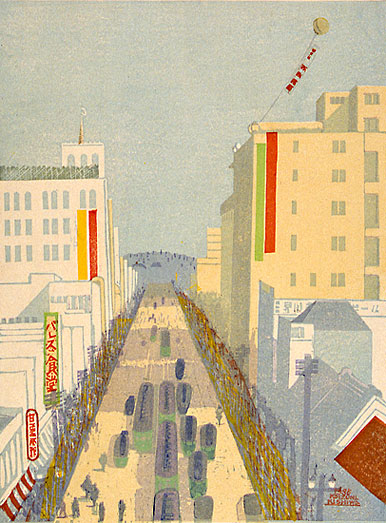
|
  “Street at Shinjuku (#61),” “Street at Shinjuku (#61),”
April 1935
Koizumi’s caption describes this part of Shinjuku as a fashionable place “for the intellectual class to gather.” What he did not mention is that the bustling avenue in this print terminates at the imperial palace.
|
| |
And the imperial presence? This resides in the distant “vanishing point” of Koizumi’s rendering of the thoroughfare, which all Tokyo residents would recognize to be the Hanzomon gate of the Imperial Palace. Unobtrusively, the imperial presence oversees the prosperity of the nation.
Militarizing the City
In 1931, just three years after Koizumi began his woodblock series, Japan seized Manchuria—China’s resource-rich “Three Northern Provinces”—and turned it into the puppet state of Manchukuo. In July 1937, three years before the series was completed, the nation embarked on a devastating war of aggression against China. In the interim, the military assumed increasing control over the political process.
Koizumi notes this militarization of domestic politics and foreign policy by peppering his street population with soldiers in khaki and singling out urban military installations in several prints. In this, his views diverge from the selections made by his eight colleagues whose 100-view subscription series was completed in 1932 and included only one truly conspicuous martial image in the form of a “military grand parade” by Kawakami Sumio. It was during the critical eight years between 1932 and 1940 that Japan’s embroilment in China grew. Whether Koizumi’s inclusion of signs of increasing military presence in the city was a matter-of-fact notation of a demographic reality or reflected an attitude that endorsed or regretted the new reality is unclear.
|
|
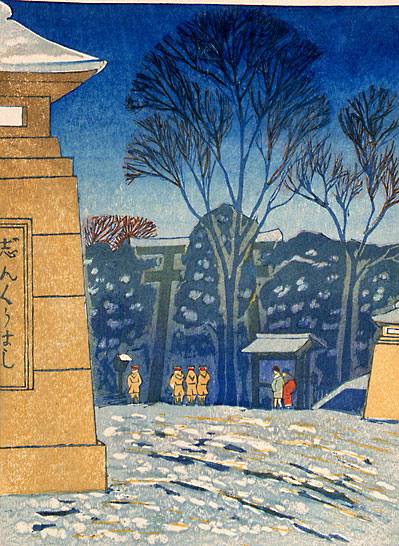
|   As with the imperial presence, the military presence is conveyed both directly and indirectly. Military figures appear in the prints from a fairly early date. To celebrate the new year of 1931, for example, Koizumi chose the Meiji Shrine in the snow as his theme, with tiny figures of soldiers by a Shinto torii or gateway giving life to the scene. As with the imperial presence, the military presence is conveyed both directly and indirectly. Military figures appear in the prints from a fairly early date. To celebrate the new year of 1931, for example, Koizumi chose the Meiji Shrine in the snow as his theme, with tiny figures of soldiers by a Shinto torii or gateway giving life to the scene. |
“Snow Covered Meiji Shrine
Bridge at Dawn (#09),”
January 1931
|
  His rendering of the Sanrentai military headquarters in Azabu (where, he tells us, Prince Chichibu once was posted) was composed in May 1932, less than a year after the Manchurian Incident. His rendering of the Sanrentai military headquarters in Azabu (where, he tells us, Prince Chichibu once was posted) was composed in May 1932, less than a year after the Manchurian Incident.
|  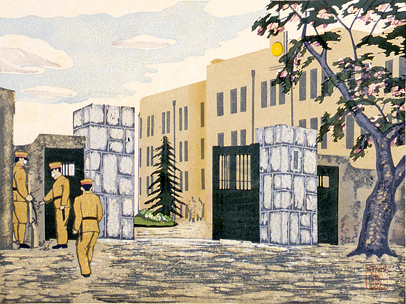
|
“The Third Regiment
Headquarters at
Azabu (#26),” May 1932
|
 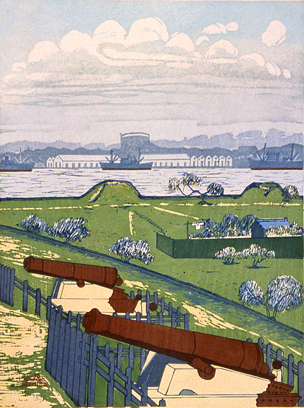
|
  In 1935, two years after Japan withdrew from the League of Nations, Koizumi produced a print depicting fortifications built in the 1850s after Commodore Perry forced the country to abandon its policy of seclusion. (His cryptic annotation for this subtle invocation of foreign threats was a single sentence reading “The Tokugawa shogunate built this battery after being surprised when the black ships of America came to Japan.”) In 1935, two years after Japan withdrew from the League of Nations, Koizumi produced a print depicting fortifications built in the 1850s after Commodore Perry forced the country to abandon its policy of seclusion. (His cryptic annotation for this subtle invocation of foreign threats was a single sentence reading “The Tokugawa shogunate built this battery after being surprised when the black ships of America came to Japan.”) |
“Battery at Shinagawa
(Fort in Edo Era) (#67),”
August 1935
|
| |
One particularly unsettling image—unusual in the oeuvre of the shin-hanga and sōsaku-hanga artists as a whole—was produced in June 1937, a month before all-out war against China was launched. This depicted the Toyamagahara firing range, where almost doll-like soldiers are seen honing their skills.
|
|

 “Army Firing Range in the Fields of Toyama [Ōkubo] (#93), June 1937” “Army Firing Range in the Fields of Toyama [Ōkubo] (#93), June 1937”
When this army firing range was established in Ōkubo during the Meiji era, it was in the countryside. By 1937, however, Tokyo had incorporated such surrounding areas. High walls were built around the compound to shield civilians from live munitions fire. |
| |
Koizumi’s favorable impression of the scene comes through unmistakably in his caption. “This is where the elite Imperial forces are trained,” he explained. “The sound of live fire is thrilling.”
The military build-up emerges in even the most prosaic of scenes. A lovely fireworks display framed by a huge torii—issued in October 1931, one month after the Manchurian Incident—evokes traditional summer and early autumn festivals and the popularity of fireworks in traditional woodblock prints.
|
|
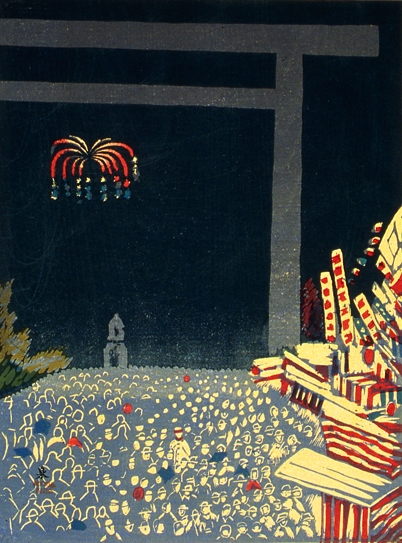
|
  Closer inspection, however, reveals that the site is Yasukuni Shrine, the very heart of veneration of those who give their lives in battle for the imperial cause. Yasukuni Shrine was dedicated to military men who died serving the Closer inspection, however, reveals that the site is Yasukuni Shrine, the very heart of veneration of those who give their lives in battle for the imperial cause. Yasukuni Shrine was dedicated to military men who died serving the
emperor. |
“Fall Festival at
Yasukuni Shrine (#19),”
October 1931
|
  Another October festival nine years later—composed as Koizumi was bringing his series to a close—captures a thoroughly modern, urban crowd with a khaki-clad soldier amongst them. The military presence was obvious, but no one could have guessed from this that Pearl Harbor lay only fourteen months ahead. Another October festival nine years later—composed as Koizumi was bringing his series to a close—captures a thoroughly modern, urban crowd with a khaki-clad soldier amongst them. The military presence was obvious, but no one could have guessed from this that Pearl Harbor lay only fourteen months ahead.
|  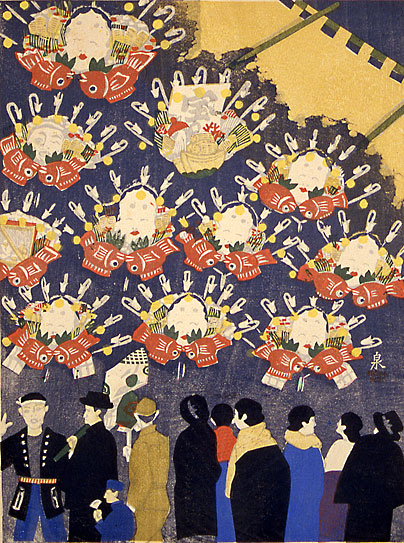
|
“Asakusa Tori-No-Ichi
Festival [Ōtori Shrine]
(#36-revised),”
September 1940
The print features the
colorful kumade bamboo
rakes associated with this
festival and thought to
ensure good fortune.
|
|
In 1942—with Japan now engaged in war on every front, and careening toward destruction that would dwarf the catastrophe of the Kantō earthquake—Koizumi’s completed “100 Views” went on exhibition in Tokyo, Osaka, and Yokohama, and full editions were offered for sale through the Asahi newspaper company. That same year, Koizumi launched a new project: a projected 36-print series of views of Mt. Fuji.
This again was, on the surface, a thoroughly conventional subject and, indeed, well-established numerology. The great Hokusai had made the iconic mountain his sole subject not only in a celebrated series of woodblock prints titled “36 Views of Mt. Fuji” (1829–1833), but also in a follow-up three-volume set of images titled “100 Views of Mt. Fuji“ (1834–1835). The perfectly symmetrical mountain, rising toward heaven as if out of nowhere, had been sanctified and venerated since ancient times. When Koizumi fixed his attention on this as his next project, however, it also had become something more notably and notoriously “modern”: a powerful nationalistic symbol of the sublime purity and perfection of the land and its people.
Koizumi worked on this final project until his death on December 7, 1945, four months after Japan’s surrender. Despite declining health, he carried out a number of trips to the environs of Mt. Fuji. As U.S. air raids in 1945 systematically destroyed his beloved “reborn” Tokyo (and 65 other cities), he took refuge with in-laws in Saitama prefecture, north of Tokyo, and at the time of his death he had completed 23 of the projected 36 views. In 1946, these were exhibited at the Mitsukoshi department store in Nihonbashi in the rubble of a metropolis once again awaiting rebirth.
23 years had passed since the earthquake, and much of what Koizumi and his fellow artists had attempted to capture in their innovative prints of a “new Tokyo” survives only in the lively impressions they left us.
|
|
|



